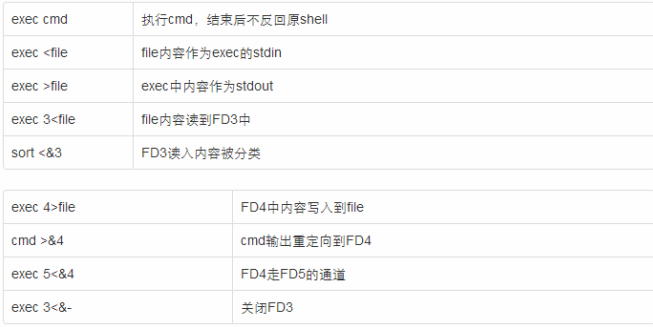Linux中的exec和source有什么区别呢?
2021-07-03 09:07
标签: Linux中的exec和source有什么区别呢? 标签:
Linux种exec和.(Source)都可以同样来执行程序或者脚本,要区别二者区别,首先了解linux下的2种命令,内部命令和外部命令:
内部命令是特殊文件格式.def实现的。
外部命令是通过系统调用或者独立程序实现的。
其次shell执行脚本的时候有两种方式:
1、当前shell下执行
2、启动子shell在子shell种执行
当shell启动子shell时候,通过fork创建进程子进程,首先子进程会继承父进程的很多属性,而非共享,再复制了父进程数据之后,2者就基本没有关系了,简单表示就是 父进程属性→子进程。fork函数和一般的函数不同,在他成功创建出子进程之后会返回两个值,一个返回给父进程中的pid变量(值为子进程ID),一个返回给自进程中的pid变量(值为0)当然,如果fork失败了,则只需要返回给父进程pid变量一个-1(子进程不存在)。子进程确实复制了父进程的数据,叫做继承了父进程的部分属性,这样一来,子进程和父进程中的变量就不是同一个变量了。
在shell种脚本得的第一行通常是/bin/bash,这种方式就是使用subshell执行,见《shell脚本编程》p36。当shell打开一个可执行文件时,系统调用fork创建进程,用于执行程序,内核执行飞编译程序
返回错误"NOT excutable format file”,shell收到错误信息启动一个新shell(shell副本)来执行,
#!(shabang)用于告诉内核使用哪个shell来执行。
现在我们查看系统帮助文档怎么介绍的:
source (.):
Read and execute commands from filename in the current shell
environment and return the exit status of the last command exe-
cuted from filename.
exec :
If command is specified, it replaces the shell. No new process
is created.
由此可见source执行的时候是当前shell环境下执行,执行完成后把状态返回给当前shell。
exec执行时候会关闭当年shell进程,并且fork一个相同pid的shell进程来执行,系统调用新的exec的process来替代原来的进程执行。从表面上看没有新的进程创建,原来进程的代码段、数据段、堆栈都被新的process所代替。
exec系统调用过程
fork()执行创建一个new_process,程序执行exec系统调用,fork()执行后父子进程共享代码段,数据空间分开,父进程copy自己的数据空间内容和上下文到子进程。采用写时copy的策略:在创建子进程时不会不copy父进程的地址空间,共用,当子进程写入数据时,这时候copy空间到子进程,这种策略提高效率并且执行fork()完执行exec后,子进程的数据会被新的进程代替。
文件描述符FD(file-descriptor)
文件在打开时候系统给每一个打开的文件分配用于维护的描述符,这通常包括系统打开文件描述符表,进程级的文件描述符表(文件操作符标志和文件句柄的引用),文件系统i-node表。(以后会单独写一个对内核源码的解释)
exec的用法表 
Example:
1、使用exec cmd
[yemo@localhost /]$ exec ls #ls 替换掉当前shell进程
bin dev home lib64 media opt root selinux sys usr
boot etc lib lost+found mnt proc sbin srv tmp var
Connection closed by foreign host. #shell已经被ls替代,ls执行完成进程结束退出
Disconnected from remote host(cent6mini_eth0) at 03:59:43.
Type `help’ to learn how to use Xshell prompt.
[c:\~]$
执行完成后关闭了shell
2、使用exec控制FD1(stdout)
[root@localhost tmp] # echo ’im lovin it’> echo.txt #简单的输出重定向
[root@localhost tmp] # echo echo.txt
echo .txt
[root@localhost tmp] # ls /dev/fd/
0 1 2 3
[root@localhost tmp] # exec >echo.t #把当前所有stdout定向到文件
[root@localhost tmp] # ls
[root@localhost tmp] # echo "i did it"
[root@localhost tmp] # cat echo.txt
cat : echo .txt: input file is output file #打开会死循环系统保护
[root@localhost tmp] # exec >/dev/tty #把stdin重新定向会屏幕(tty设备)
[root@localhost tmp] # cat echo.txt #正常输出内容
echo
echo .txt
haha
netstat
pass
rc
re.txt
sed_passwd
sudoers
yum.log
i did it
4、创建一个FD4
[root@localhost yemo] # ls /dev/fd/
0 1 2 3
[root@localhost tmp] # exec 4>4.txt #生成一个文件描述符fd4指向文件
[root@localhost tmp] # ls /dev/fd/
0 1 2 3 4
[root@localhost tmp] # echo "i feel i lose my heart" >&4 #把流通过fd4到文件中
[root@localhost tmp] # ls >&4
[root@localhost tmp] # exec 4>&- #关闭fd4
[root@localhost tmp] # cat 4.txt
i feel i lose my heart
4.txt
echo
echo .txt
haha
netstat
pass
rc
re.txt
sed_passwd
sudoers
yum.log
exec创建FD4指向文件4.txt,系统创建了FD4管道,通过管道4的内容到会传到文件4.txt中,关闭管道,否则文件占用无法打开。
来源: Linux公社